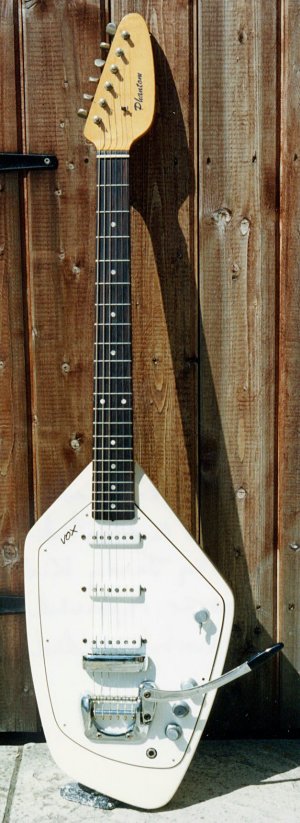
Here's a guitar that could only have been conceived and given birth to in the early sixties, it's life rendered obsolete within a few short years by more practical considerations replacing gimmick-laden imagery with the demands of the new Rock age. Just as Marshall's huge valve amplifier had stolen the march on Vox's ambitious new Solid State transistor range, so were guitarists demanding more power and tone from their instruments - qualities sadly lacking in the Phantom. Before the decade had ended, it had become an out-moded musical anachronism.
And you couldn't play it sitting down! A Phantom without a strap is practically useless; however, viewed against a dark suit, the unusual white lozenge outline cuts an impressive image, particularly striking on monochrome TV. The shape was dreamt up for Vox by The Design Centre, a London-based commercial facility that was mainly concerned with modern furniture design, their little black-and-white hang-tags adorning everything from bedsteads to cruet sets; a sort of IKEA for the New Frontier. Unfortunately, they knew nothing about the practical requirements of guitar design, but that didn't stop Vox going with the body shape and wiring a basic Stratocaster-style pick-up circuit into it.
They first appeared late in 1962, complete with 3 chrome-covered pick-ups and a tremolo unit of Vox' own design. The Phantom's shortcomings must have become apparent fairly early on, as by the summer the pick-ups had been re-designed to resemble Fender's, and the tremolo system replaced by a chrome-plated casting with nylon rollers, similar to Bigsby's. Though the body is a fairly chunky 1 3/4" thick, it's relatively small, doubtless cut from some British timber of indeterminate origin and consequently never likely to sound great. It was offered in five trendy colours - white, black, green, medium blue and light blue.
By late 1965, with Vox anxious to make room in their new workshops in Erith, Kent for the manufacture of amplifiers for the Thomas Organ Company in America (their then parent company), guitar production was moved to Italy. British components were shipped there for assembling initially, but soon manufacturing was started from scratch. It's these Italian-made models that are most often seen today, distinguished by their 3-piece bound necks and exposed truss-rod adjuster. More colour options became available, and more variations, with production continuing until 1972. 6-string Phantoms are rare, particularly the English ones, though the 12-string Italian version is quite common. As they enter the realms of antiques, which is where their real value lies, prices have become increasingly silly with the passing of time.
I bought this guitar from a car salesman in South Wales ten years ago. It was in a terrible state, neglected and scruffy, its tremolo arm and bridge cover missing, and its neck heel sawn down to lower the strings to within vibrating distance of the pick-ups' magnetic field! But it was the elusive English Vox, and I was determined to fix it up. Kinkade came to the rescue with a fabulous re-fret and finger-board chamfer, as did Paul Day, who supplied the tremolo arm (God bless the man!). I found a bridge cover in a Bristol music shop close to Kinkade's. The one-piece maple neck sports six individual tuning machines of surprisingly good quality, each stamped with the company's name. A new rotary switch now offers six pick-up options, and Vox nuts will be pleased to learn that the tone controls do indeed work backwards.
A perfectly acceptable rhythm guitar, and the very essence of British 'sixties cool. Just plug in for the instant Brian Jones effect. You gotta love it!
Recording debut: The Disappointed (staccato picking in choruses), XTC 1991.
Features on: Crocodile (XTC, 1991); video for Ballad Of Peter Pumpkinhead (XTC, 1992); You And The Clouds Will Still Be Beautiful
(un-issued solo, XTC 1998) and on the cover of Neville Farmer's "Song Stories" book.